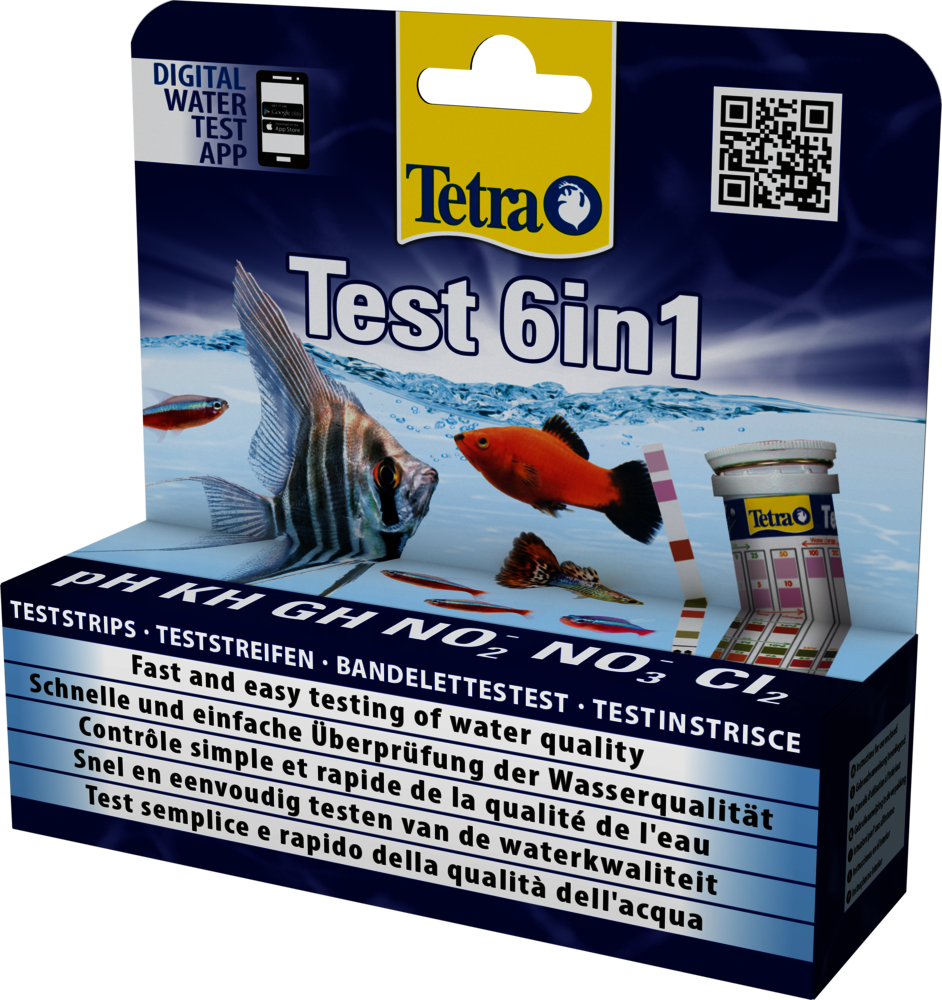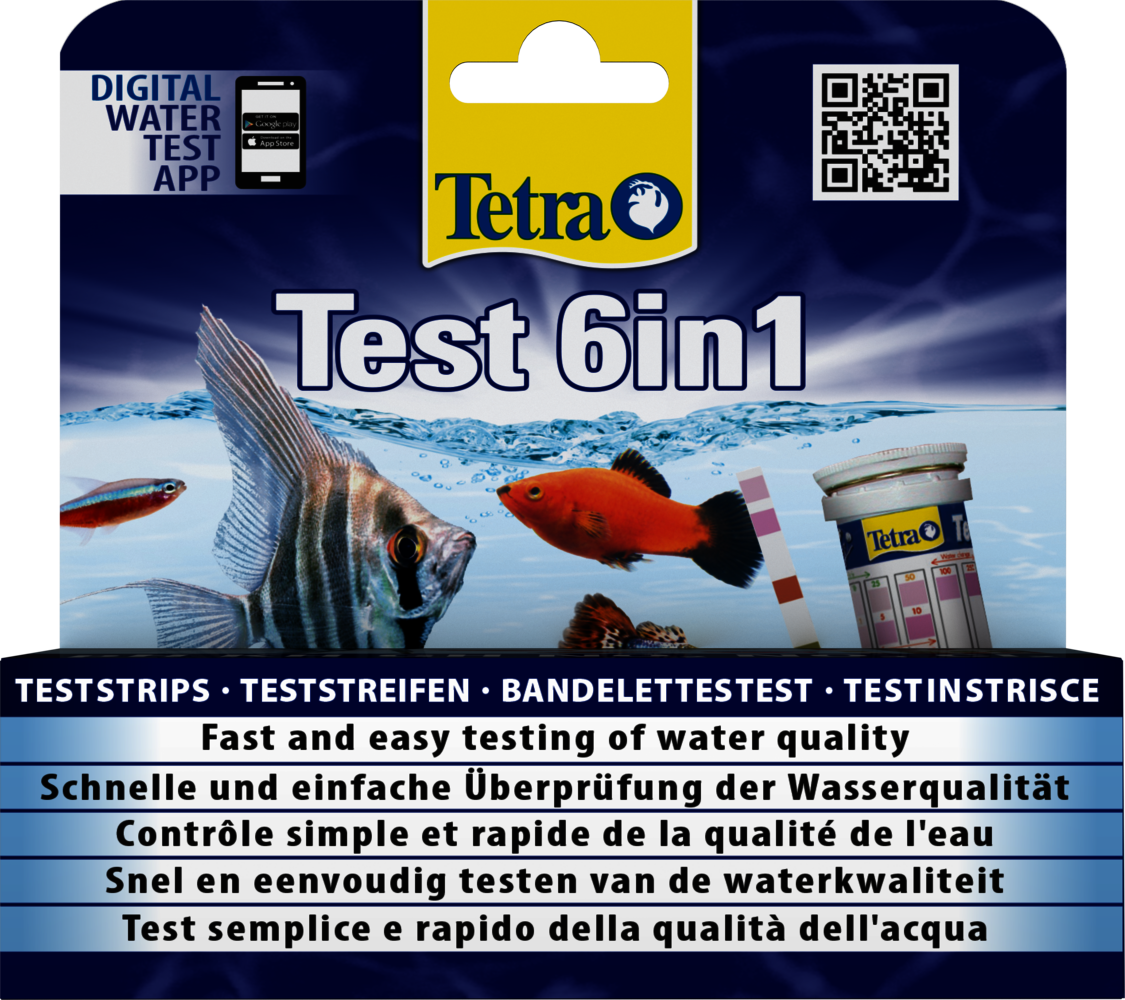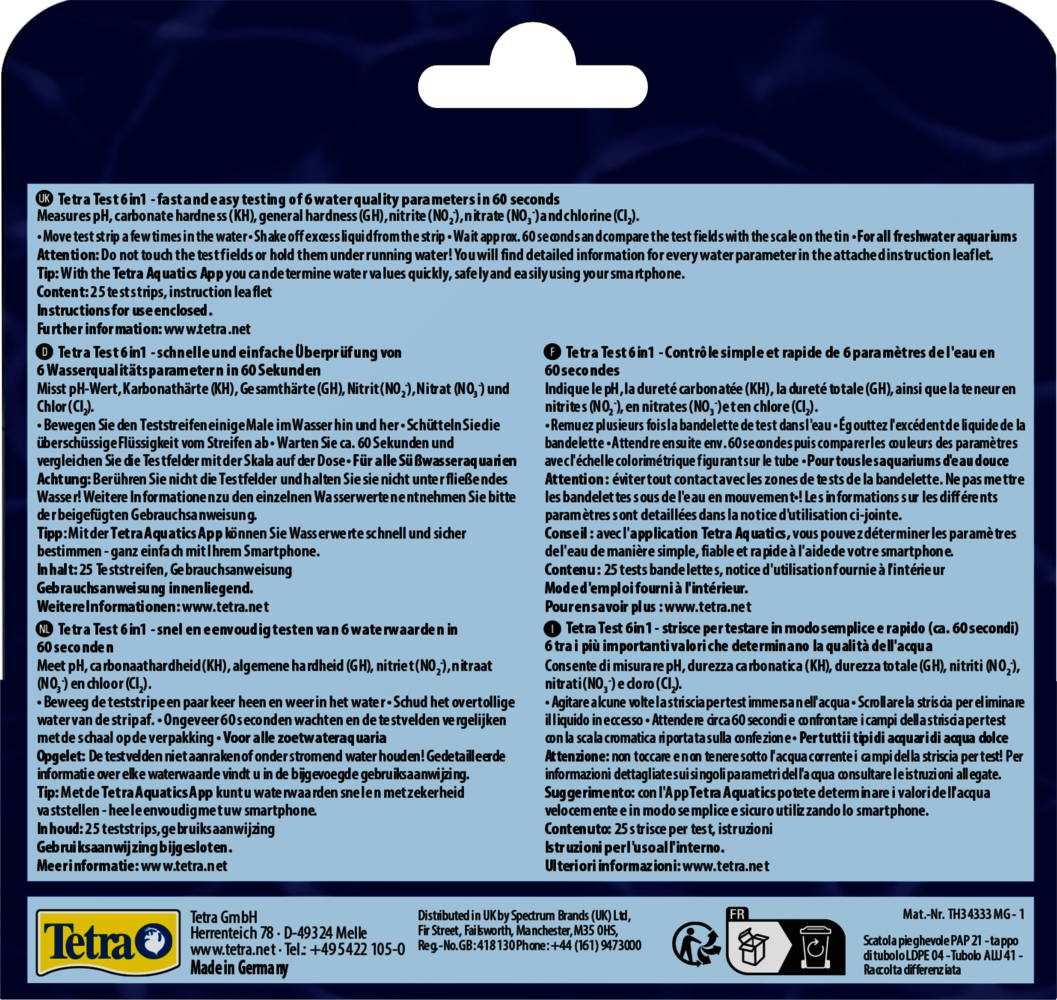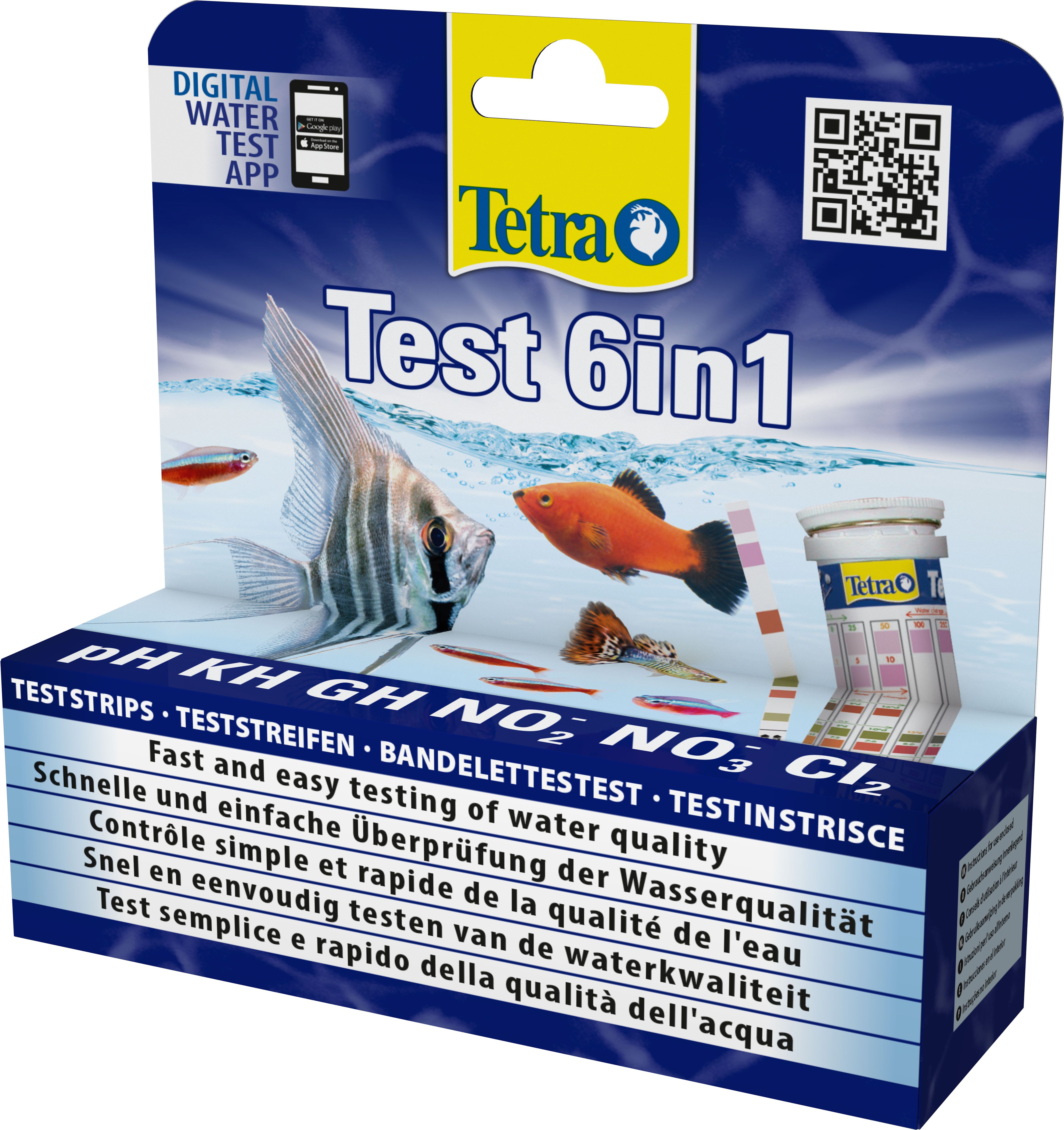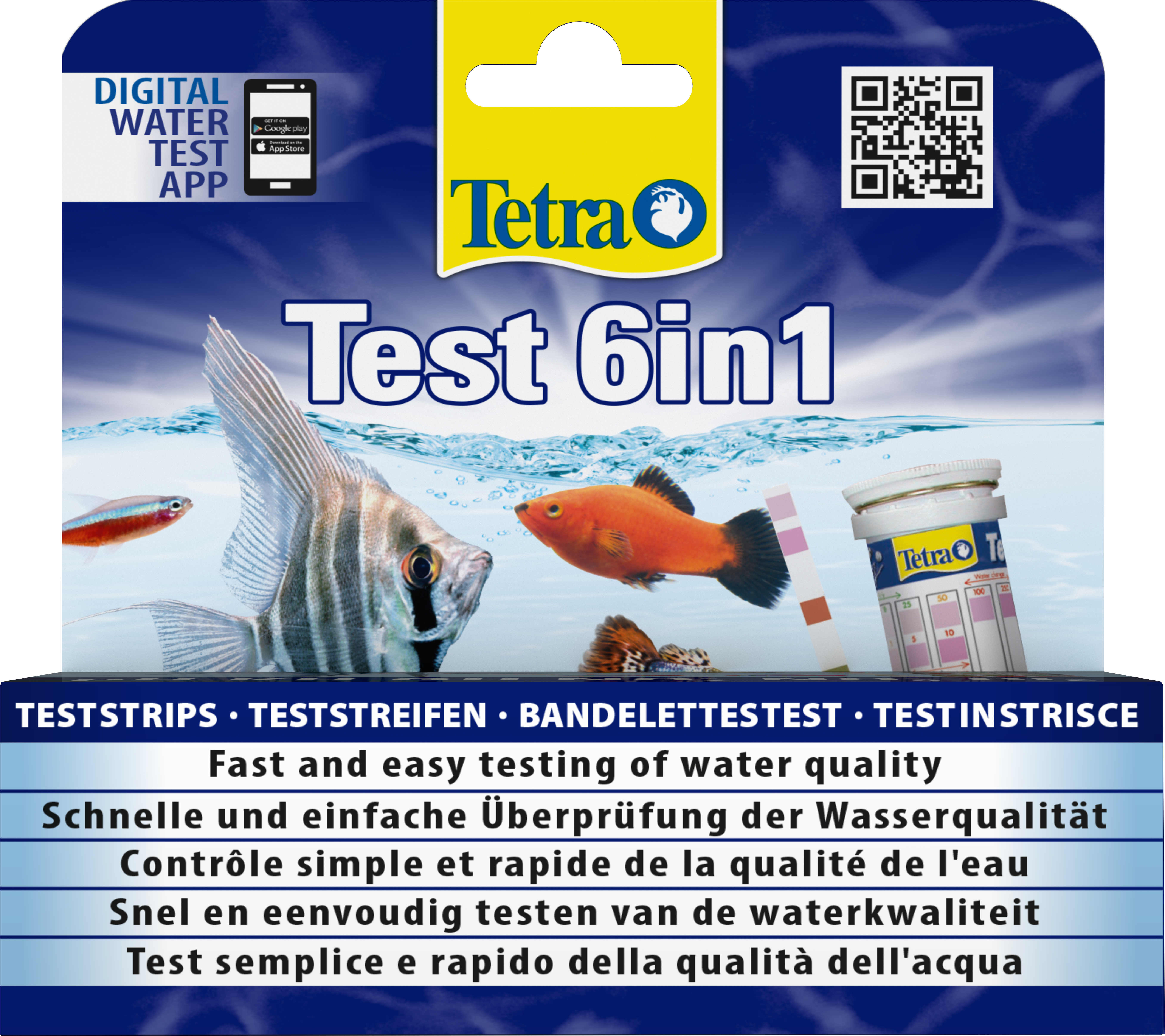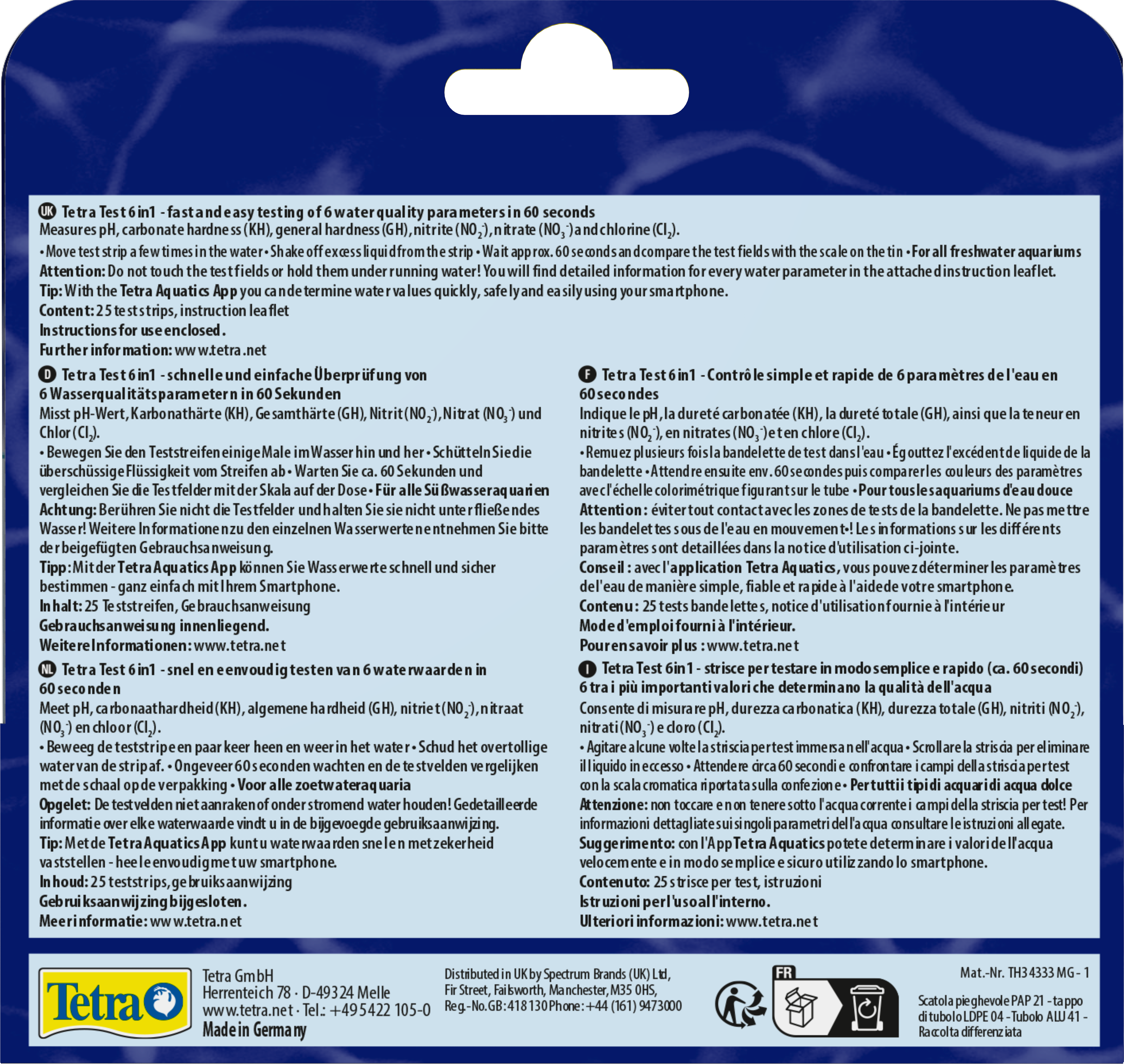Tetra Test 6in1
Water test to quickly and easily check aquarium water quality in 60 seconds: test strips measure pH, carbonate hardness (KH), general hardness (GH), nitrite (NO2-), nitrate (NO3-) and chlorine (Cl2)
- Test water parameters
- Test strips
- Freshwater aquarium
Hover Title
header
Success message
Available sizes
25 strips
Buy online
Find a nearby store
Detail
Water test to check the six most important water values in one step
Measures the pH, general and carbonate hardness (GH + KH), nitrite (NO2-), nitrate (NO3-), and chlorine (Cl2)
Full information and tips on possible countermeasures can be found in the instructions for use
Tip: with the Tetra Aquatics app you can determine water values quickly, reliably and easily using your smartphone
More information
The Tetra test strips enable you to quickly and reliably determine the six most important water values in aquariums in one simple step: dip the test strips into the water, swirl them in the water for one or two seconds, shake off any excess water and read off the most important information about the water values just 60 seconds later. The colour chart can be used to determine whether these are within the safe range. The pH, general and carbonate hardness (GH + KH), nitrite (NO2-), nitrate (NO3-) and chlorine (Cl2) in the aquarium water are measured. Aquarium inhabitants such as fish react very sensitively to excessive changes in the pH value, which impacts their well-being. The general hardness affects the vital functions of fish, while the carbonate hardness has a direct influence on the stability of the pH value (pH buffer). The test strips also measure the nitrite and nitrate values of the aquarium water. Nitrite is extremely harmful, even in very low concentrations, and should not be detectable in the water. Nitrate is a nutrient that helps plants to grow. However, excessively high levels of NO3- can be harmful to fish and promote excessive algae growth. Chlorine may also be present in the water, and is harmful to fish and plants. Just like nitrite, chlorine should not be detectable in the aquarium water. The Tetra Aquatics app can be used to determine the water values quickly and reliably using a smartphone.
Read more
FAQs
Why do I need to test the water values?
Even water that looks clear and clean may not necessarily be healthy for the creatures in the aquarium. For this reason, you should check the 6 most important water values on a regular basis, ideally every week. These are the pH value, general hardness, carbonate hardness, nitrite level, nitrate level and chlorine level. This will allow you to quickly detect any critical developments in the water quality and resolve the problem immediately.
What do I do if one of the values is not within the acceptable range?
The enclosed instruction leaflet suggests many potential solutions, such as a partial water change, adding suitable water conditioners and other cleaning measures. The Tetra website https://www.tetra.net/en/en/discover/tools/practical-tools/care-system also provides plenty of further information and measures. The free Tetra Aquatics app (https://www.tetra.net/en/en/discover/apps/tetra-apps/tetra-aquatics) is also very useful for checking water values. Simply install it on your smartphone and use it with the Tetra test strips or liquid tests.
How exactly do Tetra 6in1 test strips work?
The strips are extremely simple to use: swirl them in the water for one or two seconds, take them out and shake off any excess water. Then use the colour chart on the container (pack of 25) or packaging (pack of 10) to read off the chlorine value. You can read off the other five values after 60 seconds. If they are all within the acceptable range, then everything is great! If any of the values fall outside this range, the instruction leaflet and Tetra website https://www.tetra.net/en/en/discover/tools/practical-tools/care-system will tell you what to do. If you use the Tetra Aquatics app to calculate the values, the app will automatically suggest suitable solutions.
Can children use Tetra test strips?
Depending on how old they are, children can use Tetra test strips as long as they are assisted and supervised by an adult at all times. Many children enjoy conducting water tests, which also teach them about water biology and chemistry in the aquarium.
What’s the difference between test strips and liquid tests?
Test strips read the 6 most important water values: pH value, general hardness, carbonate hardness, nitrite, nitrate and chlorine. This provides the aquarium owner with a quick overview of the current water quality in their aquarium. Liquid tests provide even more precise readings and test for further water parameters such as the iron content, the carbon dioxide and oxygen levels.
Tetra Test 6in1
Water test to quickly and easily check aquarium water quality in 60 seconds: test strips measure pH, carbonate hardness (KH), general hardness (GH), nitrite (NO2-), nitrate (NO3-) and chlorine (Cl2)
Available sizes
25 strips
Buy Online
Detail
Water test to check the six most important water values in one step
Measures the pH, general and carbonate hardness (GH + KH), nitrite (NO2-), nitrate (NO3-), and chlorine (Cl2)
Full information and tips on possible countermeasures can be found in the instructions for use
Tip: with the Tetra Aquatics app you can determine water values quickly, reliably and easily using your smartphone
More information
The Tetra test strips enable you to quickly and reliably determine the six most important water values in aquariums in one simple step: dip the test strips into the water, swirl them in the water for one or two seconds, shake off any excess water and read off the most important information about the water values just 60 seconds later. The colour chart can be used to determine whether these are within the safe range. The pH, general and carbonate hardness (GH + KH), nitrite (NO2-), nitrate (NO3-) and chlorine (Cl2) in the aquarium water are measured. Aquarium inhabitants such as fish react very sensitively to excessive changes in the pH value, which impacts their well-being. The general hardness affects the vital functions of fish, while the carbonate hardness has a direct influence on the stability of the pH value (pH buffer). The test strips also measure the nitrite and nitrate values of the aquarium water. Nitrite is extremely harmful, even in very low concentrations, and should not be detectable in the water. Nitrate is a nutrient that helps plants to grow. However, excessively high levels of NO3- can be harmful to fish and promote excessive algae growth. Chlorine may also be present in the water, and is harmful to fish and plants. Just like nitrite, chlorine should not be detectable in the aquarium water. The Tetra Aquatics app can be used to determine the water values quickly and reliably using a smartphone.
Read more
FAQs
Why do I need to test the water values?
Even water that looks clear and clean may not necessarily be healthy for the creatures in the aquarium. For this reason, you should check the 6 most important water values on a regular basis, ideally every week. These are the pH value, general hardness, carbonate hardness, nitrite level, nitrate level and chlorine level. This will allow you to quickly detect any critical developments in the water quality and resolve the problem immediately.
What do I do if one of the values is not within the acceptable range?
The enclosed instruction leaflet suggests many potential solutions, such as a partial water change, adding suitable water conditioners and other cleaning measures. The Tetra website https://www.tetra.net/en/en/discover/tools/practical-tools/care-system also provides plenty of further information and measures. The free Tetra Aquatics app (https://www.tetra.net/en/en/discover/apps/tetra-apps/tetra-aquatics) is also very useful for checking water values. Simply install it on your smartphone and use it with the Tetra test strips or liquid tests.
How exactly do Tetra 6in1 test strips work?
The strips are extremely simple to use: swirl them in the water for one or two seconds, take them out and shake off any excess water. Then use the colour chart on the container (pack of 25) or packaging (pack of 10) to read off the chlorine value. You can read off the other five values after 60 seconds. If they are all within the acceptable range, then everything is great! If any of the values fall outside this range, the instruction leaflet and Tetra website https://www.tetra.net/en/en/discover/tools/practical-tools/care-system will tell you what to do. If you use the Tetra Aquatics app to calculate the values, the app will automatically suggest suitable solutions.
Can children use Tetra test strips?
Depending on how old they are, children can use Tetra test strips as long as they are assisted and supervised by an adult at all times. Many children enjoy conducting water tests, which also teach them about water biology and chemistry in the aquarium.
What’s the difference between test strips and liquid tests?
Test strips read the 6 most important water values: pH value, general hardness, carbonate hardness, nitrite, nitrate and chlorine. This provides the aquarium owner with a quick overview of the current water quality in their aquarium. Liquid tests provide even more precise readings and test for further water parameters such as the iron content, the carbon dioxide and oxygen levels.
Hover Title
Hover Title
header
Success message


